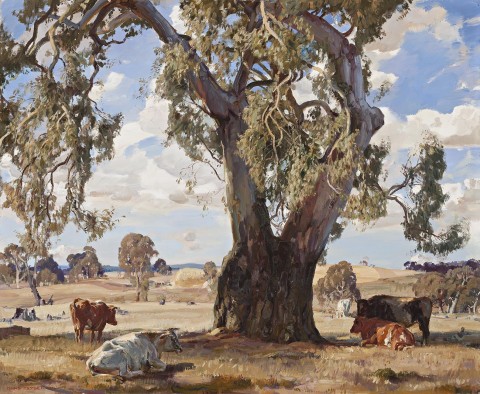THE RED GUM, 1926
HANS HEYSEN
oil on canvas
71.0 x 86.5 cm
signed and dated lower left: HANS HEYSEN 1926
Private collection
Leonard Joel, Melbourne, 20 April 1972, lot 16 (as ‘The Old Red Gum’)
Private collection
Sotheby’s, Sydney, 22 October 1986, lot 52
Private collection
Bonython Meadmore Gallery, Adelaide
Private collection
Christie’s, Melbourne, 4 April 1995, lot 44
Private collection, United Kingdom
Society of Artists’ Annual Exhibition, Education Department Art Gallery, Sydney, September 1926
Hans Heysen’s Recent Watercolours including paintings of the Flinders Ranges, Grosvenor Galleries, Sydney, 14 – 30 June 1928, cat. 18
Hans Heysen Watercolours and Drawings, S. H. Ervin Gallery, Sydney, 23 September – 23 October 1988, cat. 85
On loan to The Hahndorf Academy, Hahndorf, South Australia, 3 January – 31 March 1990
‘Artists. Annual Exhibition. An Admirable Standard.’, The Sydney Morning Herald, Sydney, 9 September 1926, p. 12
Thiele, C., Historic Hahndorf: To Honour the Occasion of His 90th Birthday and the Opening of the Hahndorf Academy, exhibition catalogue, Hahndorf Academy, South Australia, 1967 (illus. cover)
Art and Australia, Fine Arts Press, Sydney, vol. 25, no. 3, Autumn 1988, p. 307 (illus. in advertisement for Bonython Meadmore Gallery)
The noble gum and brilliance of the Australian light held Hans Heysen in their thrall, seen in The Red Gum, 1926 and related works from his golden years. While many come to mind, the best oils featuring gum trees and cattle include A Lord of the Bush, 1908 (Felton Bequest, National Gallery of Victoria, Melbourne), Red Gold, 1913 (Art Gallery of South Australia, Adelaide) and The Three Gums, 1914 – 21 (Art Gallery of Ballarat, Victoria). The year of our painting was particularly auspicious. The March number of Art in Australia was devoted entirely to Heysen, significantly including a colour illustration of The Red Gum, a watercolour version of our painting.1 He held his first solo exhibition in Sydney in May to much critical acclaim and sales of £3,800. Later, in Melbourne, the art critic for The Age heralded his show as ‘probably the highest artistic level he has yet reached’.2 Then, in December he was awarded the 1926 Wynne Prize with Farmyard, Frosty Morning, (originally purchased by Sir James Fairfax), a variation on the theme of cattle resting beneath trees.3 The previous November, Heysen had made his first visit to the Flinders Ranges. Later visits inspired such masterpieces of watercolour as Red Gums of the Far North, 1931 (Art Gallery of New South Wales, Sydney) and Guardian of the Brachina Gorge, 1937 (National Gallery of Victoria).
In his 1968 biography of Heysen, Colin Thiele quotes his perceptive understanding of gum trees: The subtlety of the tree combined with the beauty; the bulk, the solidity of the tree, and the character of its growth. And the movement, that’s something we mustn’t forget. It’s just wonderful to watch the combination of characters; sometimes you get a group of gums and you see how they combine, grow into interesting shapes, and suggest various things … I had my special trees, and they altered their appearance – the time of the year and the angle of the sun made all the difference. You could paint a tree one day and get all its various facets. And the next day it would be a different tree …4
The mid-1920s saw a burgeoning of subjects devoted to cattle sheltering beneath majestic red gums. They are crowned by our handsome oil painting and its almost identical watercolour.5 The appeal of the subject to Heysen is seen in the selection of this watercolour as one of only six chosen for colour illustration in the previously mentioned 1926 special ‘Heysen Number’ of Art in Australia. This was reconfirmed years later when Heysen chose the oil painting The Red Gum to feature in colour on the catalogue cover of the 1967 exhibition Historic Hahndorf. The exhibition was held at the Hahndorf Academy in honour of Heysen’s 90th birthday.
Different from European trees, Heysen believed that the distinctive ‘design’ of the gum was ‘expressed in the flow of its trunk and limbs …’.6 He shows this very clearly in The Red Gum where the mighty weight and shadow of the central eucalypt portrays the individuality of trunk and branches. This is given added emphasis by their striking contrast, almost silhouetted against the sun-filled light and bright blue of the cloud-decked sky. Even the atmosphere feels heavy, the enveloping stillness redolent with the lethargy of a hot summer’s day, extended through other shadows and bovine lassitude.
1. ‘Heysen Number’, Art in Australia, Sydney, 3rd Series, March 1926, no. 15, colour plate 3, unpaginated
2. ‘Art Notes’, The Age, Melbourne, 16 November 1926, p. 13
3. ‘Wynne Art Prize. Awarded to Hans Heysen’, The Argus, Melbourne, 22 December 1926, p. 22. Between 1904 and 1932 Heysen won the Wynne Prize nine times.
4. Thiele, C., Heysen of Hahndorf, David Heysen Productions, Adelaide, 2001, p. 147
5. Another particularly fine work is the charcoal, chalk and wash drawing, The Red Gum of 1924, illustrated in Dridan, D., The Art of Hans Heysen, Rigby Ltd., Adelaide 1966, pl. 49
6. Moore, W., The Story of Australian Art, Angus and Robertson, Sydney, 1934, vol. 1, p. 87
DAVID THOMAS
